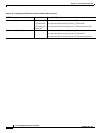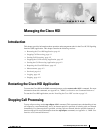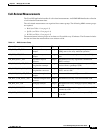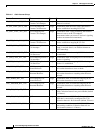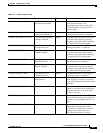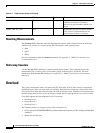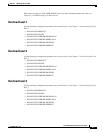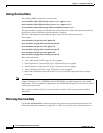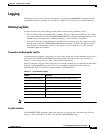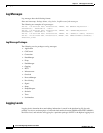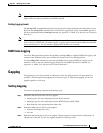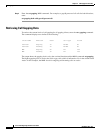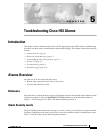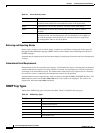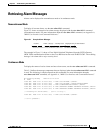
4-8
Cisco H.323 Signaling Interface User Guide
OL-4806-01 Rev. A14
Chapter 4 Managing the Cisco HSI
Overload
Setting Overload Data
The following MML commands set overload data:
set-overload:level1|level2|level3:cpu, lower=number, upper=number
set-overload:level1|level2|level3:calls, lower=number, upper=number
set-overload:level1|level2|level3:gap, filter=normal|all, percent=number
The upper parameter specifies the threshold for overload detection, and the lower parameter specifies
the hysteresis point at which the overload condition is removed.
The lower value should be greater than the upper value of the next lower severity level.
For example:
set-overload:level1:cpu, lower=45, upper=50
set-overload:level1:gap, filter=normal, percent=50
set-overload:level2:cpu, lower=63, upper=70
set-overload:level2:gap, filter=normal, percent=75
set-overload:level3:cpu, lower=81, upper=90
set-overload:level3:gap, filter=normal, percent=95
These values mean that:
• At less than 50 percent CPU usage, no call is gapped.
• From 50 percent to 70 percent CPU usage, 50 percent of calls are gapped.
• From 70 percent to 90 percent CPU usage, 75 percent of calls are gapped.
• At more than 90 percent CPU usage, 95 percent of calls are gapped.
• Before the overload level returns from level 3 to level 2, the CPU usage must fall to less than
81
percent.
Note The HSI sends a Release message to the PGW when gapping calls. The cause value is derived from the
property CCPackage,A_CC_GAPPEDCALLCAUSE, which is set to 60 (Congestion) in the default
configuration. Cisco recommends configuring the Cisco PGW2200 dial plan to reroute the call when it
receives this release cause.
Refer to the Cisco Media Gateway Controller Software Release 9 Provisioning Guide for further
information.
Retrieving Overload Data
Use the rtrv-overload MML command to display the overload status and related overload data. For
information about this command, see
Appendix A, “MML User Interface and Command Reference.”



